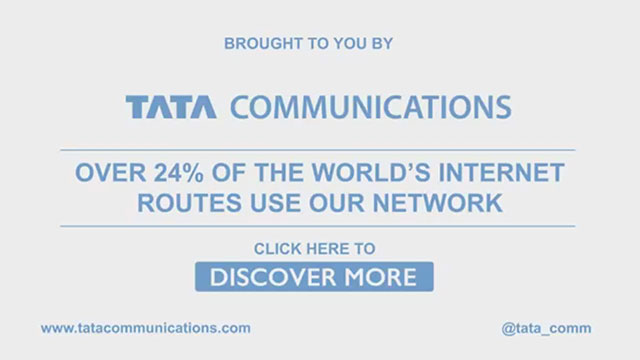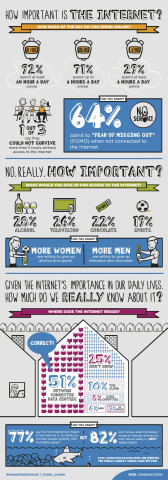MUMBAI, India--(BUSINESS WIRE)--Over 2.5 billion people are connected to the Internet today1, that’s a third of the world’s population. By 2020, the number of connected devices is expected to rise to 26 billion2. Internet use and dependence has risen to a point where ‘Fear of Missing Out’ or FOMO, often associated with modern technologies and social networking services, has become a global phenomenon. As per research conducted by Tata Communications, 64% of global citizens experience FOMO when without internet access. The survey report titled, ‘Connected World II,’ reveals responses of more than 9,400 people across six countries: France, Germany, India, Singapore, the U.S. and the UK, and offers insights into people’s behavioural associations, technical understanding and emotional connections to the Internet.
Some of the key findings include:
Emotional connections & preferences
- 64% of respondents admit to ‘Fear of Missing Out’ (FOMO) when not connected to the Internet, with Asian respondents leading in displaying negative emotions at 80%
- Global users are willing to renounce different activities for an internet connection, but alcohol (28%) seems to be the top trade-off closely followed by television (26%)
Behaviour patterns & insights
- The study shows that nearly a third of the world’s internet users spend six hours or more per day actively using the Internet
- Regional differences point to a more active internet population in Asia, where 46% of Indian and 43% of Singaporean respondents spend more than six hours per day on the Internet - significantly more than the global average of 29%. Asian respondents also appear the most internet dependent with only 48% of Singaporeans and 44% of Indians capable of lasting up to 12 hours without internet access. Their European and U.S. counterparts can go much longer without getting online, with 86% of Germans, 77% of French, 75% of U.S. and 70% of UK respondents managing up to 12 hours without internet access
Technical knowledge & expectations
- When it comes to knowing how the Internet actually works, only half of the survey respondents accurately identified network connected data centres as the place where the Internet resides, while 82% do not know that the fastest mode of internet delivery to their devices is sub-sea cables
- 64% of global respondents incorrectly believe that the Internet is infinite, and 70% believe that everyone owns the Internet with only 16% actually indicating knowledge about geo-control
- Emerging markets and the developed economies are distinctly different in their vision of the most inspirational opportunity for change in the next three to five years that the Internet can enable. Respondents from Asian countries (Singapore 32% and India 27%) picked smart cities as the most inspirational opportunity, whereas respondents from the U.S. (29%), UK (35%), France (25%) and Germany (45%) view light speed connectivity as the most inspirational
While the average global respondent revealed they could only survive a maximum of 8.9 hours without the Internet on a daily basis, 25% of total respondents are unable to make an educated guess about where the Internet resides and 67% of respondents believe that the Internet and WWW are one and the same thing – indicating an opportunity for education on the understanding and knowledge about the Internet.
According to Andrew Blum, author of ‘Tubes: A Journey to the Centre of the Internet’, “There’s a tangible, physical reality to the Internet. Undersea cables are the ultimate totems of our physical connections. If the Internet is a global phenomenon, it’s because there are tubes underneath the ocean. They are the fundamental medium of the global village.”
“The Internet has truly changed the way we function. As technologies evolve and adapt, there is a huge potential for the Internet to affect different aspects of life, economy and society. The use of these technologies will continue to expand in unexpected ways, and organisations will need to continuously explore, adapt and embrace new digital realities to thrive in,” says Julie Woods-Moss, Chief Marketing Officer and CEO of Tata Communications’ Nextgen Business. “A better understanding of the Internet is likely to improve the appreciation of the Internet and its capabilities leading to new and innovative ways to incorporate digital resources into daily activities.”
The survey results also found that 77% of respondents believe the most beneficial impact of the Internet is its ability to connect people globally with incredible speed. “This belief has been the guiding force of our business strategy in the past, and is the essence on which we have built our networks to support the present and the future. The fact that over 24% of the world’s internet routes use our network affords us a rare advantage and a perspective that helps connect with our customers globally across emerging markets and developed economies,” says Woods-Moss.
As more and more global consumers demand greater flexibility with regards to their digital footprint (connected devices, mobility, access to higher bandwidth speed and capacity), Tata Communications recognises the critical role that the Internet plays in facilitating and controlling seamless access between the IT user and service provider (internal or external). Private and business consumers are looking for that ‘just works’ internet experience that allows them to seamlessly switch their home technology to the work place and vice versa. Tata Communications is creating an open communications infrastructure ecosystem that makes the Internet Fit for Business, ensuring high quality and predictable internet that delivers a robust digital ecosystem that’s equipped for the future and that can cope with customers’ demands of intelligence, scalability and reliability.
Tata Communications' global connectivity services are built on the world's largest and most advanced global sub-sea cable network, which enables carriers and enterprises to connect almost anywhere in the world. The cable network boasts significant depth in the key emerging markets including Asia, Middle East and Africa. Over 24% of the world’s internet routes use Tata Communications’ network.
For those interested in how the Internet actually works, a video can be found [here]. The complete global report can be found [here].
About the survey
Tata Communications conducted an online survey that comprised of 14 closed questions, aimed at capturing behavioural, technical and philosophical responses in relation to people’s associations, understanding and emotional connections to the Internet. A total of 9,417 respondents across six countries: India, Singapore, UK, USA, Germany and France participated in the survey. Out of the total number of respondents surveyed, 50% of them are women and 50% men. 33% of the respondents are from Asia (India and Singapore), 52% from Europe (UK, France and Germany) and 15% from North America with age ranges: 15-25=11%, 25-35=23%, 35-45=22%, 45-55=22%, 55-65=21%. The findings of this survey were then analysed as an aggregate of the responses and further based on age, gender and location to arrive at the insights.
About Tata Communications
Tata Communications Limited (CIN no: L64200MH1986PLC039266) along with its subsidiaries (Tata Communications) is a leading global provider of A New World of Communications™. With a leadership position in emerging markets, Tata Communications leverages its advanced solutions capabilities and domain expertise across its global and pan-India network to deliver managed solutions to multi-national enterprises, service providers and Indian consumers.
The Tata Communications global network includes one of the most advanced and largest submarine cable networks and a Tier-1 IP network with connectivity to more than 200 countries and territories across 400 PoPs, as well as nearly 1 million square feet of data centre and collocation space worldwide.
Tata Communications’ depth and breadth of reach in emerging markets includes leadership in Indian enterprise data services and leadership in global international voice.
Tata Communications Limited is listed on the Bombay Stock Exchange and
the National Stock Exchange of India.
http://www.tatacommunications.com
Forward-looking and cautionary statements
Certain words and statements in this release concerning Tata Communications and its prospects, and other statements, including those relating to Tata Communications’ expected financial position, business strategy, the future development of Tata Communications’ operations, and the general economy in India, are forward-looking statements. Such statements involve known and unknown risks, uncertainties and other factors, including financial, regulatory and environmental, as well as those relating to industry growth and trend projections, which may cause actual results, performance or achievements of Tata Communications, or industry results, to differ materially from those expressed or implied by such forward-looking statements. The important factors that could cause actual results, performance or achievements to differ materially from such forward-looking statements include, among others, failure to increase the volume of traffic on Tata Communications’ network; failure to develop new products and services that meet customer demands and generate acceptable margins; failure to successfully complete commercial testing of new technology and information systems to support new products and services, including voice transmission services; failure to stabilize or reduce the rate of price compression on certain of the company’s communications services; failure to integrate strategic acquisitions and changes in government policies or regulations of India and, in particular, changes relating to the administration of Tata Communications’ industry; and, in general, the economic, business and credit conditions in India. Additional factors that could cause actual results, performance or achievements to differ materially from such forward-looking statements, many of which are not in Tata Communications’ control, include, but are not limited to, those risk factors discussed in Tata Communications’ various filings with the United States Securities and Exchange Commission. These filings are available at www.sec.gov. Tata Communications is under no obligation to, and expressly disclaims any obligation to, update or alter its forward-looking statements.
1 http://www.internetworldstats.com/stats.htm
2
http://www.gartner.com/newsroom/id/2688717




